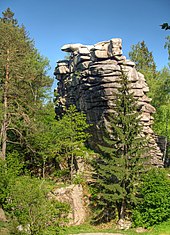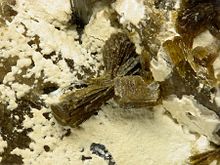Gripping stones

The Greifensteine , until around 1900 the Greifenstein , are a rock formation in the Ore Mountains in the Geyerschen Forest between the villages of Ehrenfriedersdorf , Geyer , Jahnsbach and Thum in the area of the town of Ehrenfriedersdorf in the Saxon Ore Mountains District . The highest of the seven granite rocks reaches a height of 731.7 m above sea level. NHN . Another six rocks were removed by quarrying work that ended in 1923.
geology
Geologically, the Greifensteine represent the tip of a pluton . During the Variski mountain formation , magma rose in the faults that had arisen, but cooled already below the surface of the earth. In the course of the uplift of the Erzgebirge clod , the resulting granite block also rose further. The rock layers above eroded until the harder granite was exposed . The further chemical and thermal weathering gave the rocks their current appearance with their typical " wool sacks ".
Leaching and subsequent recrystallization in the surrounding rock resulted in abundant ore deposits . After the 13th century tin - mining has been operated and 1990, the last mines had been closed for reasons of profitability, were the deposits , which were among the most productive in Europe, still not exhausted. Another example of the centuries-old mining tradition in the region is the Geyersche Binge .
Mineral finds
Due to the productivity of the ore deposits, the Greifensteine are also a well-known location for many different minerals and their varieties . So far (as of 2014) around 50 minerals and 10 varieties have been discovered here, including the well-known minerals andalusite , beryl , gypsum , hematite , muscovite , sphalerite , pyrite , topaz , wavellite and zircon as well as various garnets , tourmalines (dravite, elbaite , Schörl) and Wolframite . In addition, rare minerals such as childrenite and natrodufrénite as well as the radioactive minerals autunite and torbernite can be found here .
For the minerals fluorapatite , greifensteinite , lacroixite and roscherite , the Greifensteine are also considered a type locality .
tourism
The area around the Greifensteine is a popular excursion destination today and a protected landscape area because of the diverse flora and fauna . The viewing rock, the local museum, the Stülpner cave and the Greifensteine nature theater are all worth seeing . The Greifenbachstauweiher , the Röhrgraben and the Hormersdorfer Hochmoor are in the vicinity .
literature
- Reinhart Heppner , Jörg Brückner , Helmut Schmidt: Saxon-Bohemian panoramic mountains of the western Ore Mountains in words and pictures with tourist information , Horb am Neckar, 2001, pp. 73-75
- Günter Schubert: Greifenstein - castle, residents and mining of the 14th and 15th centuries . in: Sächsische Heimatblätter 36 (1990) No. 3, pp. 108-114
- Dietmar Werner: The Greifensteine and their legends In: Erzgebirgische Heimatblätter 1/1979 , P. 27–31, ISSN 0232-6078
Web links
- The history of the natural stage in Greifensteine in the Ore Mountains
- The information point on the Greifenstein in the Ore Mountains
- Climbing guide Greifensteine
- Greifenstein Castle. The secret of Greifenstein Castle. In: Grabsteine-erzgebirge.de. Retrieved December 28, 2014 .
Individual evidence
- ↑ Map services of the Federal Agency for Nature Conservation ( information )
- ↑ Type locality Greifensteine (Kopper quarry) , Mineralienatlas, accessed on December 30, 2015.
- ↑ Type locality Greifenstein Rocks, Ehrenfriedersdorf, Erzgebirge, Saxony, Germany , Mindat
Coordinates: 50 ° 38 ′ 56 " N , 12 ° 55 ′ 49" E




